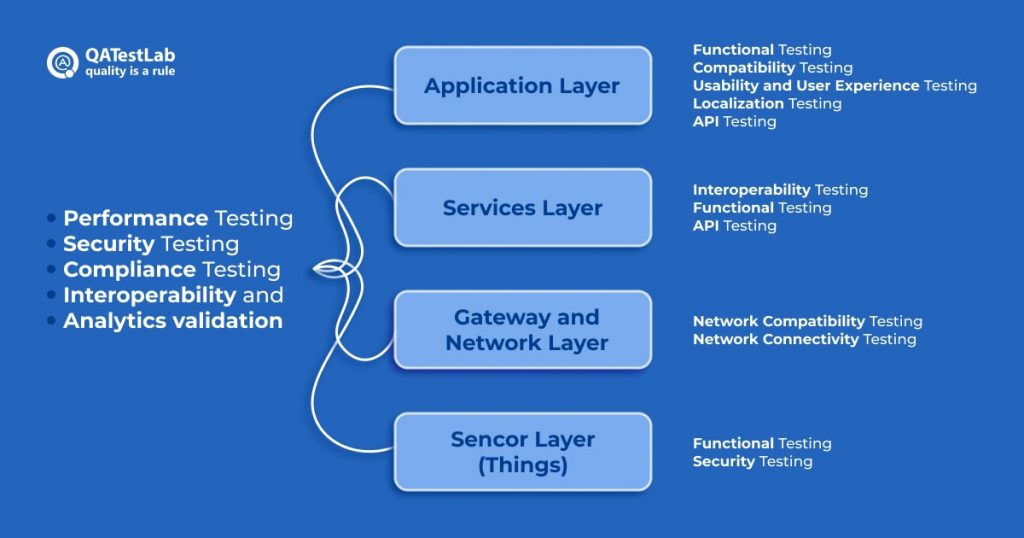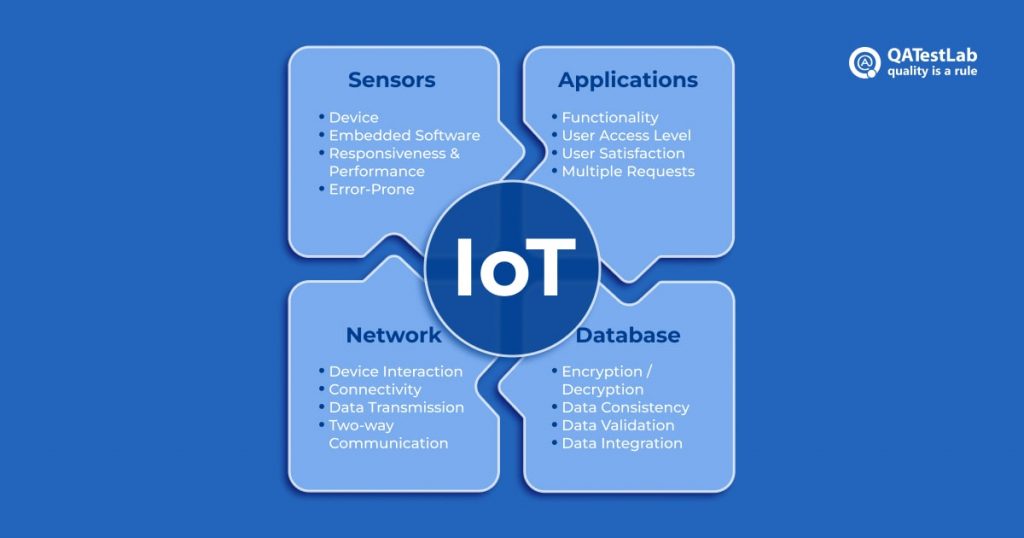Top Challenges of Testing IoT Software
by Yanina Shabanova | July 20, 2022 8:54 am
IoT technologies have been boosting the digital market for several years now. By 2023, global spending on the Internet of Things is expected to reach $1,100 billion[1]. Just by following the law of supply and demand, it is not surprising that companies are investing more in developing smart products.
But along with the enormous benefits, there are significant problems — IoT software comes with many challenges for product managers, developers, and designers. One area of IoT development that requires special and close attention is testing; this complex process[2] is critical to the smooth and productive operation of the product.
To know how to enhance your IoT software and prevent it from any dysfunctions, you need to know what potential risks can affect it. Now, get ready to find out top 5 challenges that IoT testers can come across.
Challenge 1: Variety of IoT applications and devices
Various options for hardware and software associated with IoT devices make it somewhat challenging to optimize the testing process. It can be described as including different versions of firmware and operating systems, which makes it impractical to test all possible combinations of hardware and software.
To describe a helpful section that can be adequately tested, collect data from the customers to understand what devices and software versions they use and study them to select the most common combinations.
Challenge 2: Overloading Network Channels
It is essential to remember that connected IoT gadgets rely heavily on fast connectivity. The status of the network is bound to have an impact on the IoT device’s performance. Great devices often experience problems with network infrastructure, such as changing network equipment, congested Wi-Fi channels, and moderate or conflicting web connections.
IoT devices and applications must be tested under these special conditions to ensure that they respond effectively without loss of information. Device system metrics such as processor and memory should also be verified during testing[3].

Challenge 3: Integrating IoT Points with IoT-Powered Software
The success of IoT software implementation relies on how well it integrates with existing systems. Integrations that fail to deliver the expected result or require complex training in order to learn. This leads to repercussions such as poor customer service, trouble achieving KPIs, and reduced productivity.
To resolve issues related to integration, you can use:
- Applying the API-First Approach;
- Determination of communication requirements for IoT devices, taking into account the wishes for interaction and network topology;
- Using the cloud to integrate data and processes;
- Selective use of local environment software;
- Using API Management Tools.
Challenge 4: Power Management and Connectivity
Power management standards incessantly evolve following the development in some devices. Some IoT devices such as printers are placed in locations that are accessible and depend on AC (alternating current) power. As for other devices, they can be placed in the areas that are remote, where they rely only on battery power.
Appropriate hardware and software development is a crucial concern for low-power devices, such as ensuring optimal power consumption in active and deep sleep modes or short startup/shutdown phases. Power consumption also highly depends on power-saving features, application behavior, and interaction with the wireless network.
Device and application developers, network operators, and IoT service providers require highly accurate power measurement solutions with a wide dynamic range from a few microamps to several amps. Long-term dimensions also need long-term measures covering various operating modes and network configurations.
Challenge 5: IoT Data Storage
Companies use IoT devices for collecting real-time data helping to enhance the satisfaction of customers. Sensors on all devices simultaneously generate massive data (this data is significantly complex and unstructured, which requires appropriate cleaning for final processing). Collecting, organizing, and evaluating this disparate data is not easy because the volume of data can be increased at any time. The data must be processed and transferred in the appropriate format to storage systems.
Validation of data points is key, so data loss does not become critical at this level. Failure scenarios are quite possible in data loss, so storage and cloud must be tested.
Drawing the Line
An IoT setup consists of diverse elements such as sensors, applications, networks, and data centers. Therefore, it becomes vital for the QA team to determine the different types of testing that need to be done for these different elements of the IoT. Testers must adapt to new platforms and methods to make sure they can solve IoT device and application testing challenges to provide the best end-user experience.

As an independent testing provider, QATestLab has this experience and can test usability, performance, connectivity, and compatibility for an IoT solution. As an independent testing provider, QATestLab has this experience and can test usability, performance, connectivity, and compatibility for an IoT solution. Contact us[4], and we will be glad to help you improve the software.
Learn more from QATestLab
Related Posts:
- Internet of Things is expected to reach $1,100 billion: https://www.temcom.com/intense-growth-forecasts-for-the-iot-market-until-2025/
- this complex process: https://blog.qatestlab.com/2017/04/10/iot-testing-components/?utm_source=blog&utm_medium=article&utm_campaign=iot-testing-challenges-20072022
- during testing: https://qatestlab.com/solutions/by-focus-area/internet-of-things/
- Contact us: https://qatestlab.com/request-a-quote//?utm_source=blog&utm_medium=article
- How Internet of Things Products Became our Reality: https://blog.qatestlab.com/2019/09/17/internet-of-things-products/
- Decoding the Science of Software Testing for Hardware: https://blog.qatestlab.com/2023/09/13/decoding-the-science-of-software-testing-for-hardware/
- Top Software Testing Trends in 2022: https://blog.qatestlab.com/2022/07/06/testing-trends-2022/
Source URL: https://blog.qatestlab.com/2022/07/20/iot-testing-challenges/

